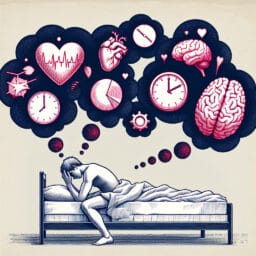
Understanding Sleep Efficiency: What It Is and How to Improve It
Table of Contents
- Introduction: What is Sleep Efficiency?
- Understanding Sleep Efficiency: Definition and Importance
- Factors Affecting Sleep Efficiency
- How to Measure Sleep Efficiency
- Tips to Improve Sleep Efficiency
- Conclusion: The Importance of Good Sleep Efficiency
- Frequently Asked Questions
Introduction: What is Sleep Efficiency?
Sleep efficiency, a pivotal metric in sleep medicine and insomnia research, is the ratio of total sleep time to the time spent in bed engaged in both sleep and non-sleep related activities. A solid understanding of this concept can herald significant improvements in individual sleep habits and overall health. Poor sleep efficiency can lead to accrued sleep debt, causing daytime fatigue and impacting one’s ability to function optimally. Factors affecting sleep efficiency vary from poor sleep hygiene such as reading or texting before bed, lifestyle choices that interfere with your natural circadian rhythm, to more serious issues like undiagnosed sleep disorders. Moreover, longer latency periods (the time span between lying down till a person finally wakes up) also contribute towards lower SE ratios. Therefore, reinforcing good habits like maintaining regular sleeping hours along with medical interventions if necessary are vital steps to improve not just the total time spent asleep but also the quality of REM and deep sleep stages experienced throughout the night. Remember that improving your ‘actual SE’ will not only help you fall asleep faster but could also reduce incidences of leg jerks or other disruptions during your final awakening period – making every moment count towards restoring your energy for a productive day ahead.
Understanding Sleep Efficiency: Definition and Importance
Touted as an important metric in sleep medicine, the interplay between sleep efficiency and overall health is profound. High sleep efficiency underscores optimal sleep quality and aligns with enhanced vitality and well-being. Conversely, poor sleep efficiency can wield a significant toll on one’s physical and mental agility, underpinning issues like daytime fatigue and cognitive impairment. Delving deeper, it can also serve as an initial red flag for underlying sleep disorders. Conditions such as insomnia or obstructive sleep apnea often manifest through prolonged periods of wakefulness during bed engaged time or frequent disruptions leading to suboptimal total sleep time (TST). In fact, research has reflected an intriguing correlation between lower SE ratios and a heightened risk of cardiac ailments, emphasizing the gravity of this seemingly inconspicuous concept.
From lifestyle choices impacting our natural circadian rhythm to nocturnal habits affecting our bedtime routine – numerous factors influencing Sleep Efficiency are within our control. Championing good sleep hygiene – including refraining from reading or texting before sleeping – can promote better rest patterns by reducing the latency period (the span from ‘lights out’ to actual onset of slumber). Moreover, mindfulness towards non-sleep related activities while in bed reinforces healthier associations between your bedroom environment and restful slumber. The journey towards improved Sleep Efficiency is indeed multidimensional encompassing behavioral shifts, timely medical interventions if necessary, along with astute attention to REM cycles and deep stages of slumber for comprehensive recovery.
| Understanding Sleep Efficiency: Definition and Importance | |
|---|---|
| Importance of Sleep Efficiency | High sleep efficiency signifies optimal sleep quality and aligns with enhanced vitality and well-being. It can also indicated potential underlying sleep disorders such as insomnia or obstructive sleep apnea. Poor sleep efficiency can lead to daytime fatigue and cognitive impairment. |
| Impact of Low Sleep Efficiency | Low sleep efficiency can correlate with a heightened risk of cardiac ailments. |
| Factors Influencing Sleep Efficiency | Lifestyle choices, nocturnal habits, good sleep hygiene including refraining from reading or texting before sleep, mindfulness towards non-sleep related activities while in bed. |
| Improving Sleep Efficiency | It’s a multidimensional journey encompassing behavioral shifts, timely medical interventions if necessary, along with astute attention to REM cycles and deep stages of slumber for comprehensive recovery. |
| Image | |
Factors Affecting Sleep Efficiency
A surprising statistic reveals that 35% of adults in the U.S. have poor sleep efficiency, illustrating just how crucial it is to prioritize quality sleep. Sleep efficiency, a significant metric in sleep medicine and insomnia research, paints a comprehensive picture of our sleep health by reflecting the total time spent sleeping versus the entire time span spent in bed engaged in both slumber and non-sleep related activities like reading or texting. Factors affecting this pivotal ratio range from lifestyle choices disrupting our natural circadian rhythm to more serious conditions such as undiagnosed sleep disorders. Poor sleep hygiene – habits that obstruct falling asleep or cause multiple wake-ups – significantly lowers this efficiency resulting in accrued sleep debt, which over time can lead to physical and mental exhaustion.
It’s important to note that high-quality rest doesn’t just mean longer hours of shut-eye but also ensuring we move through all critical stages of the REM cycle and deep slumber for complete recovery. Understanding this interconnectedness between individual sleep habits, bedroom environment, and our bedtime routine can help us take steps to improve not only our ‘actual SE’ (sleep latency) but also reduce disruptions during final awakening periods like leg jerks. So whether it’s championing good habits or seeking timely medical intervention for suspected disorders, improving your overall ‘total TST’ will undoubtedly contribute towards bolstering energy levels for a productive day ahead.
| Factor | Description | Impact on Sleep Efficiency |
|---|---|---|
| Lifestyle Choices | These may disrupt our natural circadian rhythm, affecting the quality of our sleep. | Negative |
| Sleep Disorders | Undiagnosed conditions can significantly disturb our sleep cycle. | Negative |
| Poor Sleep Hygiene | Bad habits that obstruct falling asleep or cause frequent wake-ups. | Negative |
| Quality of Rest | High-quality rest encompasses moving through all stages of the REM cycle and deep slumber. | Positive |
| Individual Sleep Habits | Personal habits, bedroom environment, and bedtime routine. | Both Positive and Negative |
| Medical Intervention | Timely medical help for diagnosed or suspected sleep disorders. | Positive |
How to Measure Sleep Efficiency
Delving into the science of sleep, researchers in sleep medicine have noted that the calculation and interpretation of sleep efficiency offers a nuanced insight into an individual’s sleep health. At the crux of this measure lies two key components: sleep latency and total sleep time. With ‘sleep latency’ referring to the time span a person takes to transition from full wakefulness to falling asleep, and ‘total sleep time’ signifying the actual duration spent sleeping within a single night, these parameters together provide an astute understanding of one’s overall rest quality.
It is intriguing to note that while longer sleep latency generally points towards poor sleep hygiene or potentially undiagnosed underlying conditions like insomnia or obstructive apnea disorders, a higher total sleep time doesn’t necessarily equate with improved well-being. Crucially, not just the quantity per se but also how we move through different stages — from light slumber through rem cycles culminating in deep restorative phases — significantly influence our physiological recovery.
Furthermore, non-sleep related activities – such as reading or texting – carried out while being engaged in bed can negatively impact this metric by creating associations between your bedroom environment and wakefulness rather than restful slumber. Consequently, it becomes clear why enhancing our understanding of factors affecting Sleep Efficiency holds paramount importance for mitigating issues like accrued ‘sleep debt’ caused due to chronic deprivation over extended periods – marking its role as an important metric within both academic research fields as well as practical applications for promoting optimal physical vitality and mental agility across populations.
| Term | Definition | Impact on Sleep Efficiency |
|---|---|---|
| Sleep Latency | Time taken to transition from full wakefulness to falling asleep. | Longer sleep latency could indicate poor sleep hygiene or underlying conditions such as insomnia or obstructive apnea disorders. |
| Total Sleep Time | Actual duration spent sleeping within a single night. | A higher total sleep time doesn’t necessarily equate with improved well-being. It is also important to consider how we move through different stages of sleep. |
| Non-Sleep Related Activities | Activities such as reading or texting carried out while being in bed. | Can negatively impact sleep efficiency by creating associations between your bedroom environment and wakefulness rather than restful slumber. |
| Sleep Debt | Accrued due to chronic deprivation over extended periods. | Understanding factors affecting Sleep Efficiency is important for mitigating issues like accrued sleep debt, promoting optimal physical vitality and mental agility. |
Tips to Improve Sleep Efficiency
A good night’s sleep is more than just a luxury, it’s a vital part of our overall health. Surprisingly, sleep efficiency can be as important as the total time we spend asleep. It encapsulates the quality of our rest by comparing actual sleep time with the duration spent in bed engaged in both sleep and non-sleep related activities. The higher your sleep efficiency, the better your chances are to wake up rejuvenated and ready for the day ahead.
Many factors contribute to poor sleep efficiency such as lifestyle choices and habits that disrupt our natural circadian rhythm, from using electronic devices before bed to consuming caffeine or alcohol close to bedtime. These activities increase our ‘sleep latency’ – the time it takes to transition from full wakefulness to falling asleep – thus reducing overall sleep quality.
One way to improve your sleep efficiency is through better ‘sleep hygiene’. This includes maintaining regular sleeping hours, avoiding stimulating activities before bedtime, ensuring your bedroom environment is conducive for sleeping (dark, quiet, comfortable), and not lingering in bed when you’re not sleepy.
Furthermore, individualized interventions may be necessary for those with underlying issues like insomnia or obstructive apnea disorders that impact their ability to fall asleep or stay asleep throughout the night. By paying attention to these elements and making small but meaningful adjustments where needed – you’ll be on your way towards improving both your ‘actual SE’ ratio and overall health.
Conclusion: The Importance of Good Sleep Efficiency
Astonishingly, around 35% of adults in America grapple with poor sleep efficiency, underscoring the urgency for comprehensive understanding and feasible strategies to improve this critical facet of sleep health. Factors affecting sleep efficiency cover a broad spectrum – from lifestyle choices that interfere with our innate circadian rhythm to individual habits such as reading or texting before hitting the sack. Such non-sleep related activities during bed engaged time elongate ‘sleep latency’, delaying the transition from wakefulness to slumber onset and reducing overall sleep quality. It’s significant to note that this isn’t just about logging more hours asleep but also ensuring we navigate through all vital stages of REM and deep sleep for restorative recovery. Accumulating a ‘sleep debt’ over extended periods due to deprivation can manifest in physical weariness and mental fog during waking hours, revealing the perils of sub-optimal sleep efficiency.
Strategies designed to enhance your actual SE ratio hinge on promoting good sleep hygiene – cultivating regular sleeping hours, abstaining from stimulating behavior prior to bedtime, and fostering a peaceful bedroom environment conducive for restful slumber. Particularly vital is resisting lingering in bed when not sleepy; this helps bolster healthier associations between your bedroom space and rest rather than wakefulness.
For those grappling with underlying issues like insomnia or obstructive apnea disorders which disrupt their ability to stay asleep throughout the night, timely medical intervention could prove invaluable. Indeed, improving your total TST doesn’t merely contribute towards enhancing energy levels for daytime productivity but may also reduce disruptions like leg jerks during final awakening periods – making every moment count towards rejuvenating your body and mind! So take charge today – mindful adjustment of our individual habits complemented by professional guidance where needed can indeed pave way for improved sleep efficiency; after all it’s an important metric at heart of robust physical vitality and sharp mental agility.


